-
As of today ICMag has his own Discord server. In this Discord server you can chat, talk with eachother, listen to music, share stories and pictures...and much more. Join now and let's grow together! Join ICMag Discord here! More details in this thread here: here.
-
ICMag and The Vault are running a NEW contest in October! You can check it here. Prizes are seeds & forum premium access. Come join in!
You are using an out of date browser. It may not display this or other websites correctly.
You should upgrade or use an alternative browser.
You should upgrade or use an alternative browser.
Defoliation: Hi-Yield Technique?
- Thread starter k33ftr33z
- Start date
- Status
- Not open for further replies.
well, you only named diseases, and tried to make a false analogy out of the naming.
You have never presented one iota of evidence to support your asinine claims about stressing seedlings.
only false analogy after false analogy.
I'll stop posting in this thread when people stop making asinine assertions.
"give an example of a person with a dormant genetic trait that shows up when stressed, please"
That is your quote!
No those are all genetic traits that manifest themselves later in life. The result is the disease or disorder, due to a stressor early in life...just like you asked. There is a gene for everyone of those disorders or diseases, but a stressor can activate the gene to cause the disease or disorder to surface. Without the stressor, it may never surface. Just like intersexed plants that get stressed, it can cause the trait to surface. Real cool to call me an idiot when I deliver proof. Typical of your arrogant ways. Later Dick H3ad
Last edited:
ooh boy... name calling... lmao."give an example of a person with a dormant genetic trait that shows up when stressed, please"
That is your quote!
No those are all genetic traits that manifest themselves later in life. The result is the disease or disorder, due to a stressor early in life...just like you asked. There is a gene for everyone of those disorders or diseases, but a stressor can activate the gene to cause the disease or disorder to surface. Without the stressor, it may never surface. Just like intersexed plants that get stressed, it can cause the trait to surface. Real cool to call me an idiot when I deliver proof. Typical of your arrogant ways. Later Dick H3ad
And lying too, claiming I called you an idiot... Classy and Mature of ya.
Traits ≠ Diseases
You did not name any traits, nor provide evidence that what happened in childhood was the impetus for the diseases you keep misnaming as dominant traits, nor did you demonstrate that stress in childhood increased the chance that it was going to show up anyhow.
If one is genetically prone to diabetes, then the same triggers are going to produce diabetes, whether or not the triggers are tripped in childhood or adulthood... Same with the other diseases you named, when you were trying to list traits...
please quit grasping at straws, not having success at it is making you mean.
You acted like pruning a sexually immature plant increased the likelihood that it would be intersexed, and you were wrong. Get over it... it is okay that you were mistaken as long as you learn from it.
Last edited:
@jwp
1. Why use clones for defoliation only?
I think its a little bit of a chicken and egg answer really.
As it doesnt really matter does it.
But ill give you the reasoning behind why i used clones.
seed A. was pot of gold from g.h.s.
seed B. was k-train again from g.h.s.
Ive worked with these 2 plants for over 2yrs now,and im quite confident that given my grow space,i know to within 1/2oz what they will yield.
Now before this thread started, i had just popped some Ak48. critical+. blue widow,ppp and a clone of cheese.
All these were from seed, and i hadn't grown any of these strains before.
Now then bare in mind that keeftree states this is a High Yield technique.
He then goes on about how he grows in a tunnel/space no more than 32x32x32 now in my mind thats quite a small area by todays standards.
My grow space is smaller than keefs and i also liked the idea of it being heigh yield.
But if i was going to give this defoil method, a fair crack of the whip then there was no point in me doing it on any of my plants that i had grown from seed.
why?
Because as i had no previous experience with them.
I thought it would be unfair to comment on weather it worked or not. (defoliation).
I could of got 10oz using this method, but i could also of got 12oz if i hadn't. i just didn't no.
So i decided to take clones of my p.o.g and my k-train as i have grown these plenty of times and in my mind i could tell if it was worth it or not.
As soon as the clones had 4 fan leafs i removed 2,let them grow for about 10 days,i then removed the other 2 remaining fan leafs,and 4 of the new ones that had grown.
I went through this process every 10 days for 7/8 wks. because i didn't have another room to flower in. so had to wait until it was empty.
From my experience with this method it shortens the plants nodal length quite considerably, and if done to aggressive can bring vertical growth to a complete standstill.
something else i noticed when i emptied my pots, i was amazed at how delicate the root structure was, i grow in straight coco and im very proud of my roots, and i new that the removal of those early fans had damaged my root growth.
How did i no this?
Because i had already grown the strain many times and knew this was abnormal.
I also think that defoliation caused an imbalance of P and K throughout the flower cycle, as the leafs felt glassy to the touch,and had a brittle feel to them,there was also a little purpling of the stems and in the middle of the plant and slight blueish tint to some of the leaf.
How did i know this.
Because i had already grown the strain many times and new this was abnormal.
I also believe there was a calcium deficiency throughout the plants cycle which was aggravated by constant removel of the oldest leafs.
How did i know this.
Because i had already grown the strain many times and new this was abnormal.
Now this might just be me being paranoid but, im convinced that this grow my weed was not as strong in flavour or smell. it did not lack any strength just didn't taste or smell like usually does.
How did i know this.
Because i had already grown the strain many times and new this was abnormal.
i could go on but im sure your getting the picture.
If i had under taken defoliation on my plants i had grown from seeds i would never of known if this was abnormal, strain dependent,plain unlucky, or bad application.
So in my mind its much better to work with something your familiar with,rather than chase your tail for an entire grow trying to fix deficiencies and problems.
i could see these problems develop as the plant grew and i could have fixed them all quite easily, and did for that matter.
But there issues that i don't get when i leave my plants alone.
I could go on but i dont want to be seen to bash the thread.
As far as yield goes i got just over 1/2 an oz more per plant so 3oz more per grow,this figure is based on the simple fact that all six plants were the heaviest id ever grown with strains i was familiar with.
But im not convinced it was the best weed ive grown and neither are my mates so for this reason alone im out.
BoB
1. Why use clones for defoliation only?
I think its a little bit of a chicken and egg answer really.
As it doesnt really matter does it.
But ill give you the reasoning behind why i used clones.
seed A. was pot of gold from g.h.s.
seed B. was k-train again from g.h.s.
Ive worked with these 2 plants for over 2yrs now,and im quite confident that given my grow space,i know to within 1/2oz what they will yield.
Now before this thread started, i had just popped some Ak48. critical+. blue widow,ppp and a clone of cheese.
All these were from seed, and i hadn't grown any of these strains before.
Now then bare in mind that keeftree states this is a High Yield technique.
He then goes on about how he grows in a tunnel/space no more than 32x32x32 now in my mind thats quite a small area by todays standards.
My grow space is smaller than keefs and i also liked the idea of it being heigh yield.
But if i was going to give this defoil method, a fair crack of the whip then there was no point in me doing it on any of my plants that i had grown from seed.
why?
Because as i had no previous experience with them.
I thought it would be unfair to comment on weather it worked or not. (defoliation).
I could of got 10oz using this method, but i could also of got 12oz if i hadn't. i just didn't no.
So i decided to take clones of my p.o.g and my k-train as i have grown these plenty of times and in my mind i could tell if it was worth it or not.
As soon as the clones had 4 fan leafs i removed 2,let them grow for about 10 days,i then removed the other 2 remaining fan leafs,and 4 of the new ones that had grown.
I went through this process every 10 days for 7/8 wks. because i didn't have another room to flower in. so had to wait until it was empty.
From my experience with this method it shortens the plants nodal length quite considerably, and if done to aggressive can bring vertical growth to a complete standstill.
something else i noticed when i emptied my pots, i was amazed at how delicate the root structure was, i grow in straight coco and im very proud of my roots, and i new that the removal of those early fans had damaged my root growth.
How did i no this?
Because i had already grown the strain many times and knew this was abnormal.
I also think that defoliation caused an imbalance of P and K throughout the flower cycle, as the leafs felt glassy to the touch,and had a brittle feel to them,there was also a little purpling of the stems and in the middle of the plant and slight blueish tint to some of the leaf.
How did i know this.
Because i had already grown the strain many times and new this was abnormal.
I also believe there was a calcium deficiency throughout the plants cycle which was aggravated by constant removel of the oldest leafs.
How did i know this.
Because i had already grown the strain many times and new this was abnormal.
Now this might just be me being paranoid but, im convinced that this grow my weed was not as strong in flavour or smell. it did not lack any strength just didn't taste or smell like usually does.
How did i know this.
Because i had already grown the strain many times and new this was abnormal.
i could go on but im sure your getting the picture.
If i had under taken defoliation on my plants i had grown from seeds i would never of known if this was abnormal, strain dependent,plain unlucky, or bad application.
So in my mind its much better to work with something your familiar with,rather than chase your tail for an entire grow trying to fix deficiencies and problems.
i could see these problems develop as the plant grew and i could have fixed them all quite easily, and did for that matter.
But there issues that i don't get when i leave my plants alone.
I could go on but i dont want to be seen to bash the thread.
As far as yield goes i got just over 1/2 an oz more per plant so 3oz more per grow,this figure is based on the simple fact that all six plants were the heaviest id ever grown with strains i was familiar with.
But im not convinced it was the best weed ive grown and neither are my mates so for this reason alone im out.
BoB
hydr1
Member
You guys are a bunch of cry babies.
I think the thread needs more of this....
Dude...I like guys like you because from what I gather you love plants. Your not here to just get high. Your not just making a buck. Your doing side by sides, breeding, loving and learning.
I left and did some learning and doing...I got some runs in...I spread my knowledge, plants, time and love.
Side by sides...knowledge...and results...documented



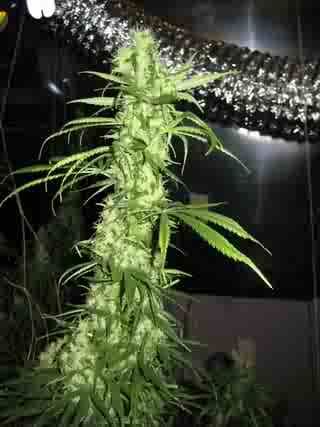



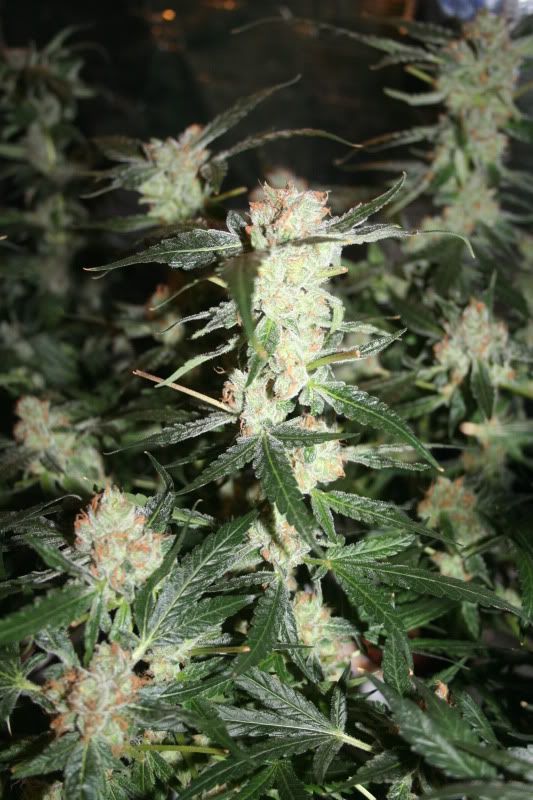

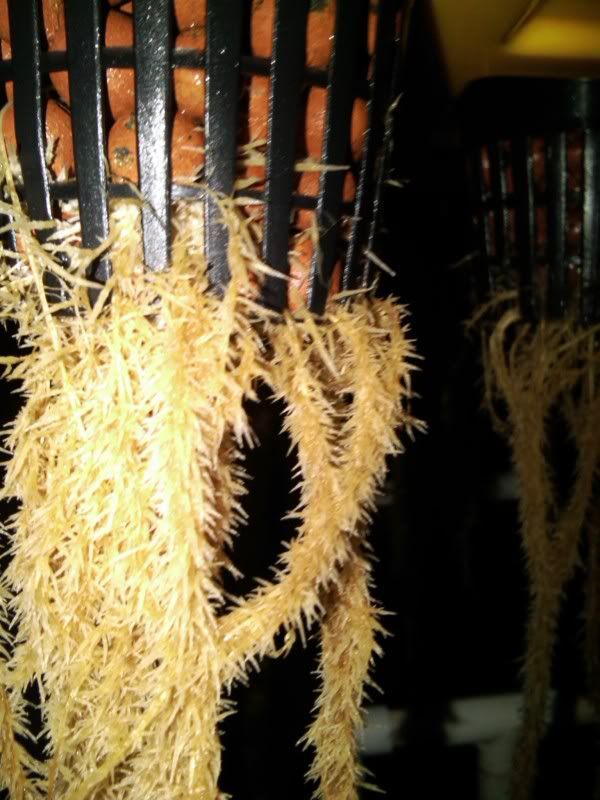
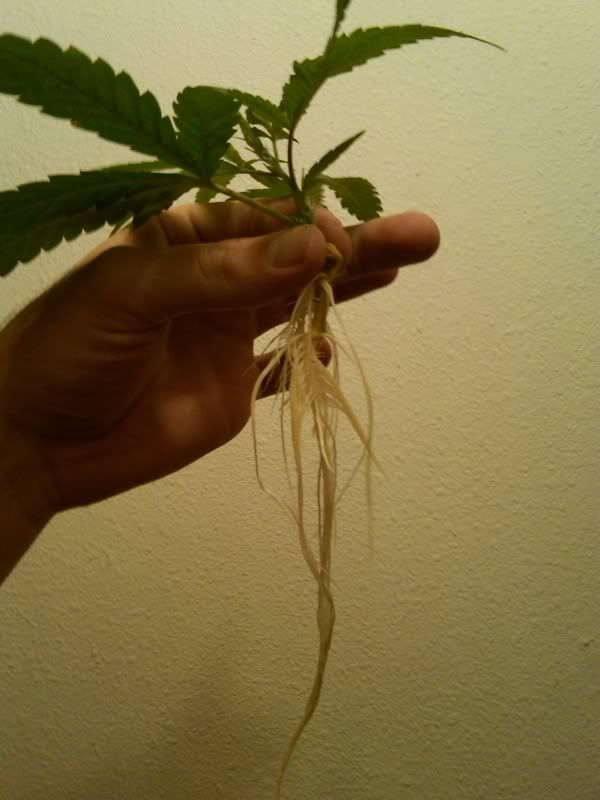
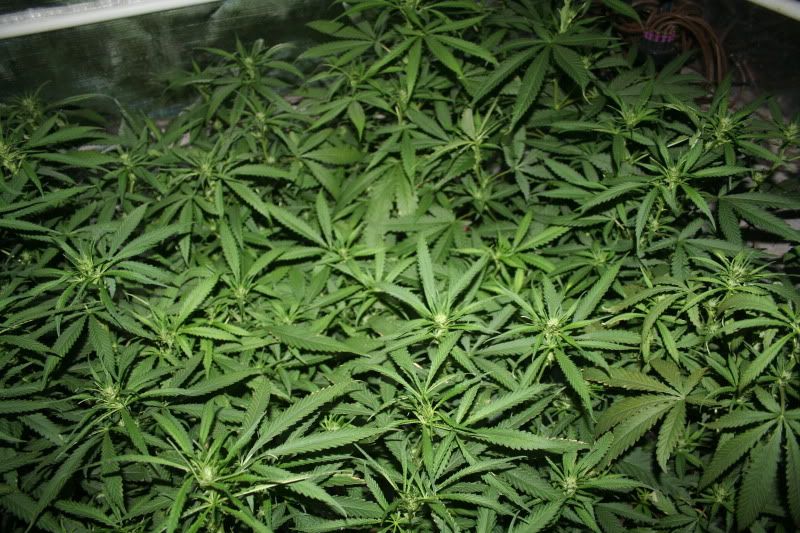
Now let's try to start new...why wait untill new years to make a resolution. To not be an argumentative bitch.
Im new here....that does not reflect my ability to rationalize or my ability to grow. Does not show what I have done or what I am doing.
The whole thing is the title here....this method may or may not increase yield. Genetics and environment are 90% of that...the rest could be good luck or skill growing.
If you use this method and it works...post..if it doesn't work ...post that too. But for god sake...stop with the bitch madesquabble and pages of useless bantering.
Thanks...like I said ill be doing some side by sides with this in aero, ebb and flow and soil. Peace
Hydr
I think the thread needs more of this....
Dude...I like guys like you because from what I gather you love plants. Your not here to just get high. Your not just making a buck. Your doing side by sides, breeding, loving and learning.
I left and did some learning and doing...I got some runs in...I spread my knowledge, plants, time and love.
Side by sides...knowledge...and results...documented












Now let's try to start new...why wait untill new years to make a resolution. To not be an argumentative bitch.
Im new here....that does not reflect my ability to rationalize or my ability to grow. Does not show what I have done or what I am doing.
The whole thing is the title here....this method may or may not increase yield. Genetics and environment are 90% of that...the rest could be good luck or skill growing.
If you use this method and it works...post..if it doesn't work ...post that too. But for god sake...stop with the bitch madesquabble and pages of useless bantering.
Thanks...like I said ill be doing some side by sides with this in aero, ebb and flow and soil. Peace
Hydr
Howdy, Boerman-- Thanks. Yes, the plant was also FIM'd early on and grown with vertical lighting. All branches end up roughly the same size. The branching on this pheno became especially uniform.
Interesting. I have never FIM'd. Not opposed to it, just never got around to learning it. But I am getting plants that look like they have been FIM'd; almost all of the ones that I have been plucking from early veg. I didn't set out trying to do anything other than keep my clones shorter so I have been pondering what exactly it is that I am doing that is causing the bottom branches to catch up with the main stem. I will post my thoughts on it, with pics, in a bit.
For anyone that still interested in this technique, it works but take your time to learn it and do it right, you wont get it down the first or 2nd try, keep on trying... it will work
also someone said join date = newb at growing

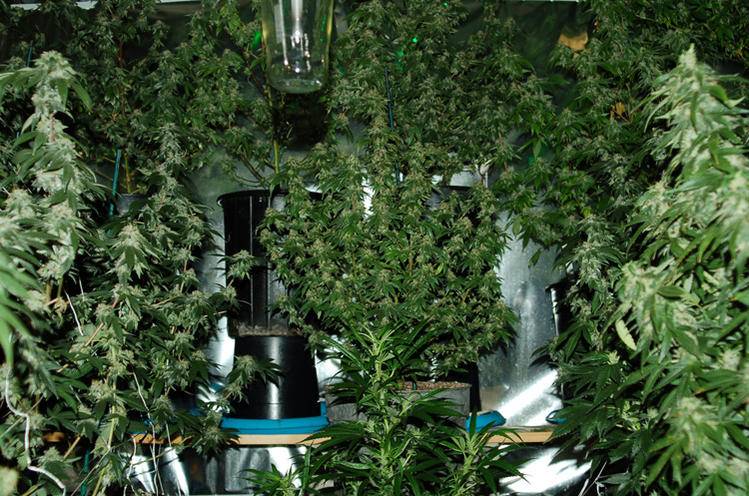
cheers,
red.
also someone said join date = newb at growing

cheers,
red.
3 more weeks to go or so
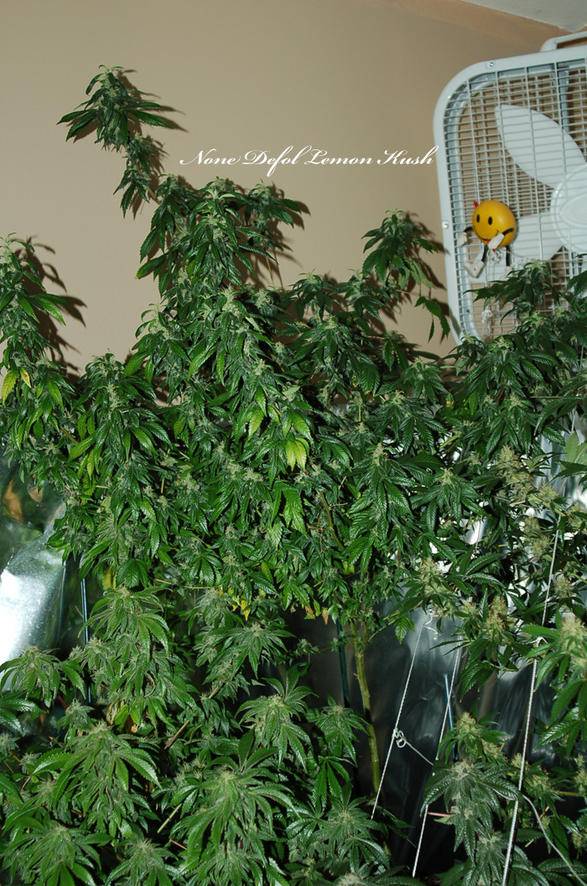
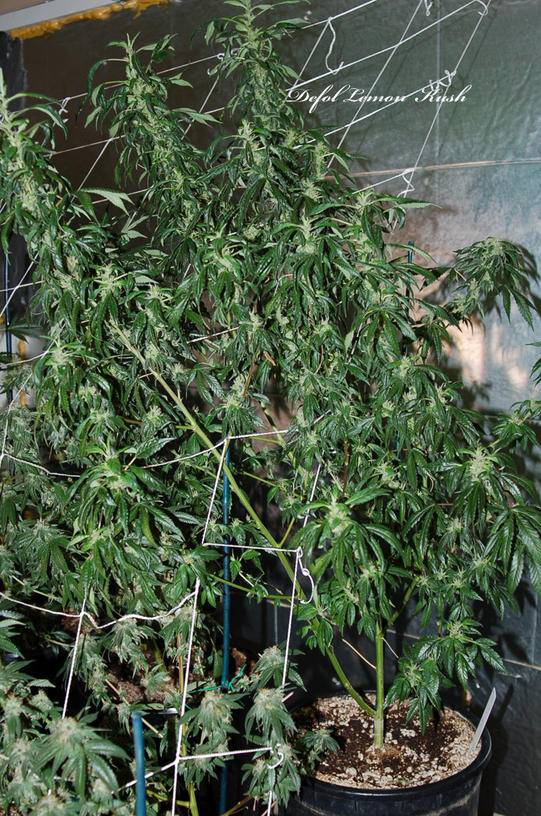
cheers,
red.
cheers,
red.
D
dramamine
Is this image an accurate demonstration of defoliation and FIMing?
Because i connot see any juncture on that plant where the FIM technique has been properly used.
I guess you missed! lol
In answer to your rhetorical question, yes it is. I can't see what you possibly have to gain by calling my techniques into question. Seems like you just have a real appetite for insults and pedantry. It doesn't matter to me whether or not you can see and understand how I grew my plant! It's weird that you feel so threatened by this defoliation technique that you must attack anyone involved for whatever reason you can grasp at.
This thread is entertaining now, I guess, but any real discourse and discovery has been spoiled by the militaristic approach of some, including and especially you. Strange that some of you feel at liberty to insult and dismiss the actual experiences of others. I'm sure you're all old enough to know that you can't negate reality through denial.
Edit: I'll show you how to FIM if ya ask nice!
ooh boy... name calling... lmao.
And lying too, claiming I called you an idiot... Classy and Mature of ya.
Traits ≠ Diseases
You did not name any traits, nor provide evidence that what happened in childhood was the impetus for the diseases you keep misnaming as dominant traits, nor did you demonstrate that stress in childhood increased the chance that it was going to show up anyhow.
If one is genetically prone to diabetes, then the same triggers are going to produce diabetes, whether or not the triggers are tripped in childhood or adulthood... Same with the other diseases you named, when you were trying to list traits...
please quit grasping at straws, not having success at it is making you mean.
You acted like pruning a sexually immature plant increased the likelihood that it would be intersexed, and you were wrong. Get over it... it is okay that you were mistaken as long as you learn from it.
Those are not diseases or disorders until stressed...they are suppressed genes that when stressed can trigger symptoms and if stressed as a child, might not show up til later. Now you want symptoms? Go f yourself, look it up yourself...I know better! Like you said, Get over...its okay you were mistaken as long as you learn from it!
Last edited:
Fo20Blazerrr
Member
I've got to admit that this thread has become quite addictive for me now, it's usually one of the first things I look at when I get here.
Watching a small band of hardcore defoliation believers defend themselves and refuse to budge against the forces of knowledge, experience and common sense just gets funnier every day. I particularly like the way that they refer back to the "old days" when everyone on the thread was a happy defoliator sharing their love of the word of k33fter, despite the fact that the first person to call bullshit did so before the end of the first page.
I'm glad to see that as soon as one sane person gives up trying to argue reason and leaves the thread another one steps up to take over.
Can we please have lots more pictures of stringy bald looking plants with a few poor to mediocre buds on them as "evidence" of this high yield technique? They always make me laugh.
The way i see this thread,,,
The OP posted an old technique that been going on decades but there isnt any type of online community like this one to give it a NAME, and start debate over it NAME first, then debate if its going to work or not ,,,
There are quite a few people that took this practice in the wrong way, thus damaging themselves and come back crying or saying it doesn't work ....
The one that actually have experiences are the one that posted up pictures and use real common senses to prove their points,,,, the nay sayer should post up their fail/dieing plant as well ...
This isn;t easy, it take years to learn and perfect, OP did not posted that in the first post, anyone said this does not work obviously didnt grow enough plants in their life yet ....
FO20.
JWP
Active member
Yeah because your join date to a pot site = experience.
Im new here....that does not reflect my ability to rationalize or my ability to grow.
also someone said join date = newb at growing
Where did i ever say that?
Read the whole post an you will realize that i'm insinuating that some names arent even "real" people.
How anyone can read what i posted and think that i'm saying a join date has anything to do with a persons growing ability is amazing.
JWP
Active member
Wow look at the difference!
How long until these two are finnished mate?
Flowered & finnished at the same time?
Those are not diseases or disorders until stressed...they are suppressed genes that when stressed can trigger symptoms and if stressed as a child, might not show up til later. Now you want symptoms? Go f yourself, look it up yourself...I know better! Like you said, Get over...its okay you were mistaken as long as you learn from it!
diseases and traits are two different things and you've made no point. I never asked for diseases or symptoms of diseases as a plant being monoecious is neither...
Comparing human diseases to plant sex is a false analogy.
Last edited:
diseases and traits are two different things and you've made no point. I never asked for diseases or symptoms of diseases as a plant being monoecious is neither...
Comparing human diseases to plant sex is a false analogy.
H3ad can we just Agree to Disagree and call it a day? We do not see eye to eye and it is just getting nowhere. My apologies to you and everyone for the back and forth. Please continue with defoliation conversations.
Speaking of defoliating....I just got done defoliating 6 plants on day 20 flower. Never defoliated them in Veg. They look great and are budding well already. They are in a small tent, with a 600 watt cool tube. I will post some updates in a week. Another tent I have has some plants that were defoliated in veg many times and a few times in flower. They will be finishing up next Sat. All of the buds are similar size with zero fluff. Also, they are finishing up faster than normal. I am taking full term for proper flush...but they could be picked almost week early if they were flushed sooner.
Beach Bum420
Member
I found this site a while back and thought i would check it out. Like all growers I was hoping to find new insights and techniques that might help me to become better at what I do.
I have found several things that helped. However, the thing I have found most prevailent here are a bunch of young wannabe's who have read a few posts and suddenly think themselves experts at the art of marijuana cultivation. IMO most of them have never grown a plant at all, and if they have tried, have failed miserably. You know who you are and you dishonor the other newbs who are sincere in their desire to become good growers.
You also offend the truly experienced growers who spend their valuable time trying to help others.
To all you posers and haters I can only say sit yourself down, have a bowl, mellow out, close your ignorand mouths and try very hard to actually learn something.
I started growing back in 1968 when the only viable indoor grow lights were 40w flourescent tubes. There was no such thing as designer nutes. There were no books on growing the plants we love so well. we learned by trial and error. We sought out other growers and picked each others brains, smoked each others products and had some amazing good times. What we did then has developed into what is avaliable to ypu now.
Back in the days of flourescent tubes, dirt from the woods composted with lawn clippings, cow manure, and worm castings was the no1 growing medium, processes like selective defoliation, sea of green or screen of green could double your crop production.
With the advent of modern lighting along with generations of dedicated underground farmers hard work and research we now have systems and nutrients where any dummy can grow a respectable crop.
Lets get to this thread though, defoliation (done properly) can increase production by 10 to 15%.
If you choose not to believe that , well tharts ok too. Go find what will work for you. Being a hater and nay sayer only shows how ignorant and closed minded you are.
To the real growers on here.
Peace and love to all of you!
Da Beach Bum
I have found several things that helped. However, the thing I have found most prevailent here are a bunch of young wannabe's who have read a few posts and suddenly think themselves experts at the art of marijuana cultivation. IMO most of them have never grown a plant at all, and if they have tried, have failed miserably. You know who you are and you dishonor the other newbs who are sincere in their desire to become good growers.
You also offend the truly experienced growers who spend their valuable time trying to help others.
To all you posers and haters I can only say sit yourself down, have a bowl, mellow out, close your ignorand mouths and try very hard to actually learn something.
I started growing back in 1968 when the only viable indoor grow lights were 40w flourescent tubes. There was no such thing as designer nutes. There were no books on growing the plants we love so well. we learned by trial and error. We sought out other growers and picked each others brains, smoked each others products and had some amazing good times. What we did then has developed into what is avaliable to ypu now.
Back in the days of flourescent tubes, dirt from the woods composted with lawn clippings, cow manure, and worm castings was the no1 growing medium, processes like selective defoliation, sea of green or screen of green could double your crop production.
With the advent of modern lighting along with generations of dedicated underground farmers hard work and research we now have systems and nutrients where any dummy can grow a respectable crop.
Lets get to this thread though, defoliation (done properly) can increase production by 10 to 15%.
If you choose not to believe that , well tharts ok too. Go find what will work for you. Being a hater and nay sayer only shows how ignorant and closed minded you are.
To the real growers on here.
Peace and love to all of you!
Da Beach Bum
JWP
Active member
Lets get to this thread though, defoliation (done properly) can increase production by 10 to 15%.
Mate this is the problem. People say 10-15% increase with absolutely no evidence.
In fact the evidence apears to be the opposite.
Look at the two plants above for example. The defoliated one looks to be at least 10-15% smaller.
As I clearly stated: this is conjecture and speculation on my part. I am not saying that this is the way it is, only that this is the way I am looking at it.
Your logic is quite twisted there. You've gotten a few things wrong. It is the large fan leaves that fuel bud growth. Ive seen this on my own plants that suffered from a horrible zinc deficiency. The areas where fan leaves remained green and active had larger buds, while the fan leaves that were decimated by Zinc deficiency had buds that were miniature. The large fan leaves provide a much greater surface area for photosynthesis to occur than over bud leaves. Its even been said in this thread that removing the fan leaves has resulted in smaller buds on their plants.
Well, Dave, my logic may be twisted. I don't know. But your logic is incomplete. Try thinking past the fan leaves. Do you think a deficiency stops at the fan leaves? In the areas where the fans were effected by the deficiency, the bud leaves would be deficient as well. Your example can't really prove anything because if my idea is correct, then your poor results would have happened even if the fans had been removed. In fact, it can be argued that the fans could have been a factor in causing the deficiency by hogging nutes that were needed by the bud leaves to do their work of building buds. And, BTW, gawwdddddaaammmnnn! 158 pages and you saw where someone said that removing fans resulted in smaller buds. You mean you never saw where anyone had more buds, harder buds, bigger buds on the lower branches, 25% more yield????? You have a pretty selective memory.
You are also incorrect on the amount of mobile nutrients stored in the fan leaves. They have quite a bit. Have you ever witnessed a mobile nutrient deficiency occur in your plants? It starts with the oldest and largest fan leaves, then progresses to the smaller leaves, and bud leaves. N, P, K, Cl, Mg, Mo, are mobile nutrients, and the largest leaves will of course have the greatest concentration of these nutrients that can be consumed by the newer smaller growth when supplies are limited.
Again, not much depth to your thinking. I couldn't possibly be "incorrect on the amount of mobile nutrients stored in the fan leaves" because I didn't give an amount. I didn't say anything about mobile nutrients per se. When I said that big fans may provide little, if any, actual nutritive support for buds, I was talking about the products of photosynthesis. But, since you want to talk mobiles, yes, I have witnessed mobile nutrient deficiency. But I also took the time to learn what was going on. You should give that a try sometime. Your thinking on this is exactly the opposite to what is going on. Your plant is very efficient. The reason it starts cannibalizing the oldest and biggest fan leaves is because they are expendable. Think about the life cycle of a leaf. It starts out just a little nub on a branch. It uses materials produced by other parts of the plant to begin developing. As it gets bigger, it begins to supply some of its own needs and rely less on other parts of the plant. There comes a point where it starts producing more than it needs and begins to support other parts of the plant. There comes a time when its production begins to decline until it eventually is producing less than is needed to keep it alive. Sooner or later the plant sucks all the remaining value out of it and lets it drop off. When a plant starts to suffer a deficiency, it is not going to sacrifice its most productive member to fix it. It is going to sacrifice its oldest, least valuable member. That would be that big old fan leaf that you love so much. They don't have the greatest concentration of nutrients. They are just the most expendable.
I will agree with you that fan leaves fuel growth for that node they are attached to. This is pretty easy to see if one observes their plants when placed under nutrient stress.
See, at least you got something right.
- Status
- Not open for further replies.


